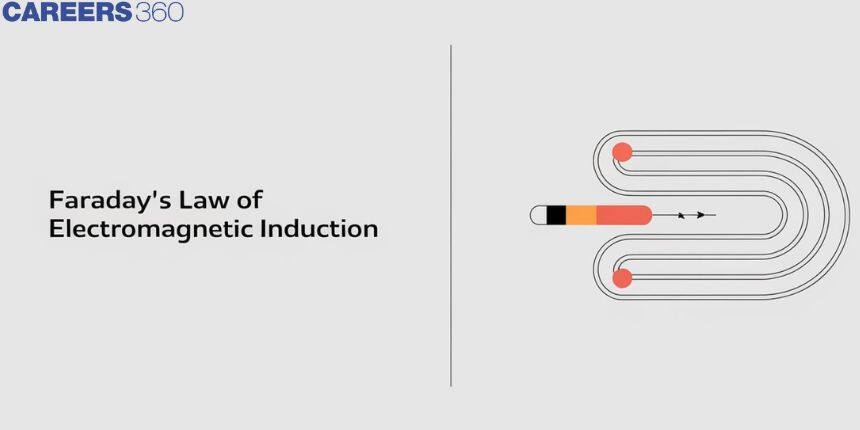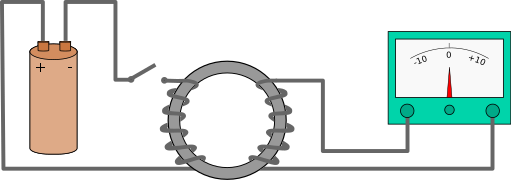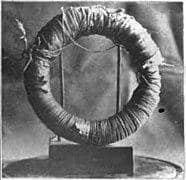Faraday's Law of Electromagnetic Induction
Faraday’s Law of Electromagnetic Induction is one of the most important concepts in physics and electrical engineering. Discovered by Michael Faraday in 1831, this law explains how an electromotive force (EMF) is induced in a conductor when the magnetic flux linked with it changes. It forms the basic principle behind electric generators, transformers, inductors, and many modern electrical devices. Understanding Faraday’s first and second laws helps students clearly grasp how electricity can be produced from magnetic fields. This topic is especially important for Class 12, JEE, and NEET examinations, where both theory and numerical problems are frequently asked. In this article, Faraday’s experiments, laws, derivation, and applications are explained in a simple and exam-oriented manner.
This Story also Contains
- Faraday's First Law of Electromagnetic Induction
- Faraday’s 2nd Law
- Derivation of Faraday's Law
- Explanation of Faraday’s Experiments
- Faraday's First Experiment
- Faraday's Second Experiment
- Faraday’s Law of Electromagnetic Induction
- Lenz's Law
- Applications of Faraday’s Law

Faraday's First Law of Electromagnetic Induction
“Whenever a conductor is put in a fluctuating magnetic field, an electromotive force is induced,” according to Faraday's first law of electromagnetic induction. A current is induced when the conductor circuit is closed, and this is known as an induced current.”
$
\mathcal{E}=-\frac{d \Phi_B}{d t}
$
where,
- $\mathcal{E}$ is the induced EMF
- $\Phi_B$ is the magnetic flux
- $\frac{d \Phi_B}{d t}$ is the rate of change of magnetic flux
Faraday’s 2nd Law
The induced emf in a coil is equal to the rate of change of flux linkage
$
\mathcal{E}=-N \frac{d \Phi_B}{d t}
$
where,
- $\mathcal{E}$ is the induced EMF
- $N$ is the number of turns in the coil
- $\Phi_B$ is the magnetic flux through the circuit
Derivation of Faraday's Law
Magnetic flux is given as
$\Phi_B=\int \vec{B} \cdot d \vec{A}$
For a uniform magnetic field vector
$\Phi_B=B \cdot A \cdot \cos \theta$
Differentiating both sides to get the rate of change of magnetic flux
$\frac{d \Phi_B}{d t}=\frac{d}{d t}(B \cdot A \cdot \cos \theta)$
Substituting terms we get
$\mathcal{E}=-N \frac{d \Phi_B}{d t}$
For a coil of N turns
$
\mathcal{E}=-N \frac{d \Phi_B}{d t}
$
Explanation of Faraday’s Experiments
What is the Electromagnetic Induction Experiment, and how does it work?
The mechanism through which a current can be made to flow due to a magnetic field transition is known as electromagnetic induction.
Experiment by Michael Faraday
In 1831, Faraday observed that when the number of magnetic field lines in a circuit changes, an induced EMF is formed in the circuit, a process known as electromagnetic induction. The current runs through the circuit when it is closed, and this is known as the induced current. While the magnetic flux fluctuates, the induced EMF and electric current endure only a short time. Faraday and Henry are two examples of this type of work.
Faraday's First Experiment
- A closed circuit with an insulated wire coil.
- Also, because there is no source of EMF in the circuit, there is no deflection in the galvanometer.
- When we advance the bar magnet towards the coil while keeping the coil fixed (say), the needle of the galvanometer deflects, indicating the current pressure in the circuit.
- This deflection is only visible for the period of time that the magnet is moving. The galvanometer needle is now deflected in the other direction if we press the magnet in the opposite way.
- The deflection is now in the other direction if we move the magnet towards the coil with its south pole facing coil, suggesting that the current set in the coil is now in the opposite direction as when the north pole faces the wire.
- When the magnet is stationary and the circuit is moved away from the magnet, the galvanometer shows deflection.
- The velocity of the magnet is likewise observed to be higher, as is the deflection of the galvanometer needle.
- Faraday deduced from this experiment that moving the magnet in one direction toward the coil had the same effect as moving the coil in the opposite direction toward the magnet.

Faraday's Second Experiment
- The deflection is now in the other direction if we move the magnet towards the coil with its south pole facing coil, suggesting that the current set in the coil is now in the opposite direction as when the north pole faces the wire.
- When the magnet is stationary along with the circuit moving away from the magnet, the galvanometer shows deflection.
- The velocity of the magnet is likewise observed to be higher, as is the deflection of the galvanometer needle.
- Faraday deduced from this experiment that moving the magnet in one direction toward the coil had the same effect as moving the coil in the opposite direction toward the magnet.
Faraday’s Law of Electromagnetic Induction
The creation of electromotive force across electrical conductors in a changing magnetic field is called magnetic induction. Induction was discovered by Michael Faraday in 1813 as well as it was mathematically characterized as Faraday’s law of induction by James Clerk Maxwell.
Electromagnetic Induction According to Faraday’s law:
- The time rate of change of magnetic flux in the circuit equals the magnitude of the induced emf in the circuit. The induced emf can be calculated using the formula $\mathcal{E}=-\frac{d \Phi_B}{d t}$.
- The negative sign indicates that the current generated in a circuit frequently flows in such a way that it opposes or causes the change.
In the case of a tightly wound N-turn coil, the flux change associated with each turn is identical. As a result, the expression for the total induced emf is -
$
\varepsilon=-\mathrm{N}(\mathrm{~d} \phi / \mathrm{dt}) .
$
Lenz's Law
Statement:
Lenz's law states that the direction of induced electromotive force (or induced current) in a conductor is such that it always opposes the cause which produces it.
Whenever there is a change in magnetic flux linked with a conductor, an induced current is produced in it. According to Lenz's law, the induced current flows in such a direction that the magnetic field produced by it opposes the change in magnetic flux responsible for its production.
Mathematical Expression:
$
e=-N \frac{d \Phi}{d t}
$
The negative sign indicates that the induced emf opposes the change in magnetic flux.
Example:
When a magnet is moved towards a coil, the induced current produces a magnetic field that opposes the motion of the magnet.
Applications of Faraday’s Law
An electrical transformer is a common use of Faraday’s law. A transformer is made up of two independent coils wound around a piece of iron. The primary coil is one of two, while the secondary coil is the other. Due to Faraday’s law, this shifting field will induce a current in the secondary.

Other applications are:
- Faraday’s ring transformer
- Electric generators
- Electromagnetic brakes
- Metal Detectors
Also read:
Frequently Asked Questions (FAQs)
The Faraday is a non-measuring electric charge volume unit equivalent to about 6.02 x 10^23 electric charge carriers.
According to Faraday’s law, a fluctuating magnetic flux generates an electric field. Faraday’s law is particularly essential since it deals with the E-field-B-field relationship and recognizes that this connection necessitates flux variation over time.
Electrolysis is a technique for eliminating iron oxide that involves delivering a tiny electrical charge from a battery or battery charger through rusted metal to stimulate ion exchange while the device is submerged in an electrolyte solution.
The cathode is the negatively charged electrode created by electrolysis. In electrolysis, the positively charged electrode is known as the anode. Ions with a negative charge are travelling towards the anode.
The force in any closed circuit due to a change in the flux linkage of the circuit is called electromotive force EMF, according to Faraday’s law.